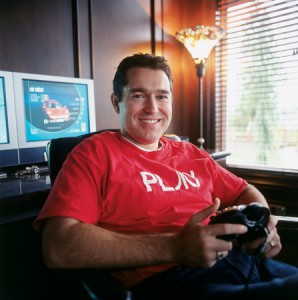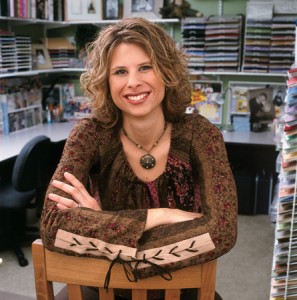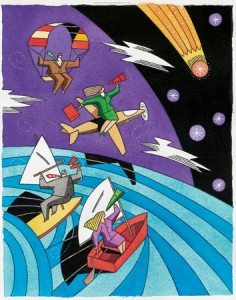Following their entrepreneurial instincts, many BYU graduates find success by perceiving a trend and skillfully riding the current.
In March 1995 the NASDAQ hovered at 800. Stephen J. Jenkins, ’94, hovered at the Marriott School. Early that year Jenkins—an MBA student and a self-described computer nerd—decided other nerds needed his help. He started writing articles, help files, and tip sheets for Windows 95 users and used a nerdy emerging medium to distribute his insights. Windows95.com was born.
The World Wide Web was a logical distribution choice. The same folk who would stand in line all night to buy the first copies of Windows 95 certainly knew what the Internet was—even if many other people didn’t at the time. Getting visitors to his site was not Jenkins’ biggest problem. His biggest problem was how to pay for the bandwidth to keep up with all those nerds.
“It really started out as a hobby, but it turned into an expensive hobby,” Jenkins remembers. “I needed to make about $2,000 a month to cover the costs.”
That $2,000 became a quandary for his student budget. He put out some feelers to sell $500 ad spots but got no response. Then, on a whim just before he was going to abandon his expensive hobby, he adjusted the cost. “I still don’t know why, but for some crazy reason I added a zero on the price of the ads—so instead of $500 per month, I wanted $5,000 per month,” he says.
Call it perceived value or new-economy mayhem, but the extra zero did the trick and Jenkins started selling ads. Before he finished his MBA in 1996, he was meeting his $2,000 monthly costs—with more than $50,000 per month to spare. Jenkins realized he had a business, not a hobby, on his hands.
It doesn’t happen quite like this for all successful entrepreneurs, but the ingredients are the same: identify a fledgling trend, sense a need in the market, or find a new niche; then add plenty of hard work. An aligned star or two is also helpful.
Among those entrepreneurs with a knack for perceiving “the next big thing” are many BYU graduates. The stories that follow illustrate how four alumni entrepreneurs, including Jenkins, have turned their intuition, insight, luck, and hard work into business success.
REPEAT OFFENDER: STEVE JENKINS
Steve Jenkins started young. With a Commodore 64 and a dot-matrix printer, 10-year-old Jenkins created a mailing list for his mom’s employer. He maintained the list for free, but charged for each label he printed. On his mission in France, he became the informal mission supplier of imported food like peanut butter, Kool Aid, and root beer. When he entered MBA school, he and his classmates were required to buy a specific type of calculator. So Jenkins contacted a wholesaler and sold the calculator for $5 less than the BYU Bookstore—outfitting half his class, Jenkins estimates.
That Jenkins stumbled across a lucrative idea like Windows95.com, later named WinFiles.com, seems natural for someone with his entrepreneurial history. It should also seem natural that Jenkins and his coworker, Jeremy D. Young, ’96, launched another company on the heels of WinFiles’ success. Young suggested licensing some of the software they had developed to efficiently run WinFiles. They branched out in 1996 and created Virtual Servers (known as VServers), a hosting company that offered server space along with technologies to do things like manage databases and sell products online. The marketing strategy for VServers was simple and effective: promote the services through unsold ad slots on WinFiles.
By fall 1996 Jenkins and Young had moved to Seattle and by all counts were successfully running and growing two new-economy companies. But fresh out of business school, Jenkins didn’t know what the new economy was. “I wasn’t really an experienced business person. I had just gotten out of business school, and the only thing I knew was old economy,” Jenkins says.
So he and his partners stuck to old-fashioned formulas that seemed to be working well—for WinFiles it was to provide really good, really fresh content for a very specific audience; for VServers it was to attract customers using the high traffic on WinFiles and to provide an exceptional service at a reasonable price.
In the meantime, the Internet revolution hit its stride, and financial markets reflected the euphoria of the new economy. In early 1999 the NASDAQ was on its historic run up, almost tripling in the four years since Jenkins had begun WinFiles. In February 1999 the NASDAQ passed through the mid 2,000s, and Jenkins inked a deal to sell WinFiles to a large technology Web site, CNET. But CNETconsidered its stock undervalued and offered Jenkins cash. They agreed on $11.5 million.

Steve Jenkins knows how to play the high-tech entrepreneur game. At age 10 he began winning with a mailing-list service he ran on his Commodore 64. At age 29 he scored big by selling two technology companies while dot-coms were still in the lead . Now he and his team provide computer – and video-game secrets to hundreds of thousands of people.
At the end of 1999, VServers was also courted for acquisition. “It was déjà vu,” recalls Jenkins. Micron approached Jenkins and his partners and, also considering their stock undervalued, offered a cash deal of $48.5 million. With the NASDAQ nearing 4,000, Jenkins was getting suspicious of the euphoria and closed the cash deal by year’s end.
As a final touch, Jenkins had established an investment strategy that included cashing out of all his personal stock holdings. He did so in March 2000 just as the NASDAQ hit its all-time high of more than 5,000. Its precipitous fall began by April, and Jenkins had completely cashed out. He was 29 years old.
His Midas touch wasn’t without some startling lessons, however. The most profound came in 1999 while being courted by Micron. He and his wife, Kay-dawn, had a baby boy, Chandler, born with a congenital heart defect. After a four-month battle, Chandler passed away. Just a few weeks later, the money from the VServers sale came in. “I was disgusted with it,” he says. “What I learned in a very hard way is that money isn’t everything. The most important things, it can’t do.”
Jenkins took 2000 off to regroup. Today he, two family members, and a friend run a site called CheatCodes.com in which they provide video- and computer-game tips, tricks, and, yes, cheats to help players advance through a game’s levels. Despite the current market, the young company is profitable and has a bright future. The computer- and video-game industry is holding its own in an otherwise hostile technology environment. Jenkins has found another burgeoning trend, and he sticks with the old mantra of providing good, fresh content to a niche audience. So far, so good.
Next on the docket for Jenkins is a PhD, then he’d like to do what his professors did for him and teach some good, old-fashioned business principles to the next generation of entrepreneurs. “I had great luck, and I’ll take all the luck I can get. But I still credit my professors, business partners, employees, and family for helping me take advantage of that luck,” he says.
HOGIS AND YOGIS: MIKE CLAYTON
KFC sells a lot of chicken. Michael P. Clayton, ’85, knows because he did the books for 250 locations while working as a CPA for Coopers and Lybrand. But counting chickens was wearing thin, and in the late 1980s Clayton began wondering if he could cook them instead.
So with the plan of opening a few fast-food restaurants, Clayton did some research and discovered that 1) everyone needs to eat, 2) they are going to eat out more often, and 3) they want healthier choices.

Healthy and fast are the main ingredients in Mike Clayton’s success. He began by combining yogurt and sandwiches on the menu of the fast-food restaurant. He later added an oriental fast-food concept to the mix. The recipe so far has yielded 80 stores in seven states, and Clayton has plans to be nationwide in five years.
Feeling confident that healthy fast food was the direction Americans were going and, therefore, he should go too, he settled on the concept of fresh sandwiches and nonfat frozen yogurt. It was named at the family dinner table when his mother asked about his idea, “Why don’t you do something with your hogis and yogis?” And there was no turning back.
In 1989 he opened his first two Hogi Yogi stores in Logan and Orem, Utah. It didn’t take long, however, to realize that counting chickens and cooking them were two very different things.
“I had a lot of failures in the first few years,” Clayton recalls. “I found out that to run a business you need to not only know how to put together a financial statement, but you also have to know about marketing, legal work, trademarks, and dealing with people.”
There were missteps to be sure—like egg salad, for instance. “My grandmother told me you have to have an egg sandwich,” Clayton remembers. “And not one person ordered it.” So he stopped buying eggs and changed all his menu boards.
He continued to wade through, and the tide turned when his brother, Rick P. Clayton, ’92, graduated in marketing and decided to open a Hogi Yogi franchise in Provo. “Overnight, because of his skills with people and his ability to market, we had lines out the doors,” Mike says.
From then they split the responsibilities and played to their strengths. Rick headed up operations and marketing, and Mike handled the behind-the-scenes business development. It was a winning combination, and they franchised 12 stores per year for the next six years.
In the meantime, the pair bought the building next door to the Provo location to ward off would-be competitors. The Claytons decided to try their hands at another fast-food concept, and, drawing from Mike’s mission experience in Japan, they created Teriyaki Stix. It, too, struck a chord in the fast-food industry—healthy and hot—and soon became the perfect year-round complement for summer sandwiches and yogurt. Today almost every Hogi Yogi location includes a Teriyaki Stix.
“It goes right along with our healthy and fast concept,” Mike says. “We don’t cook our food in grease—it’s all grilled and fresh. That’s how we differentiate ourselves from everyone else.”
It seems to be working. Overall, the fast-and-good-for-you trend has held up. One of the Claytons’ primary competitors, Subway, announced in 2002 that it had more locations in the United States and Canada than McDonald’s. And even McDonald’s, Burger King, and other burger joints are offering everything from grilled chicken to premium salads to fruit and yogurt.
Hogi Yogi and Teriyaki Stix haven’t surpassed McDonald’s with locations, but they continue to see rapid growth. There are 80 stores throughout the western United States, and Mike and Rick have big plans. They are working on superstores that will add a third concept to the mix—a bakery called Glazies. They intend to be nationwide within five years.
“To be successful and make something work,” says Mike, “is really rewarding—a lot more than the money. To see something work and see people like it, that’s really what it’s all about.”
GUTSY: LISA BEARNSON

For Lisa Bearnson, crafting a top magazine meant taking a page from her own book. Gluing together he editing trade, her scrapbooking hobby, and her commitment to family, she persisted on instinct, defying experts who said a scrapbook magazine couldn’t cut it. Her publication, Creating Keepsakes, is now read by half a million people.
Lisa Downs Bearnson, ’88, was told by industry experts that her idea was unresearched, too expensive, and above all, corny. But she and her partner, Don K. Lambson, couldn’t shake the feeling that they were onto something. So they made note of the feedback—and disregarded it.
Having worked for WordPerfect Magazine as editor-in-chief, Bearnson knew something of magazine publishing. Having spent night after night making scrapbooks for her four kids, Bearnson also knew something of scrapbooking. And when her days at WordPerfect hit a personal slump, she got a bee in her bonnet to marry her knowledge wells.
“I did some research and discovered that there were no scrapbooking magazines,” says Bearnson. She invited Lambson, the art director at WordPerfect Magazine, to partner with her, and they and their spouses set out to create a magazine dedicated completely to scrapbooking: Creating Keepsakes.
To help them get started, they attended a magazine conference in Los Angeles in 1996 and shared their idea with experts they met there. In every case they were told it would fail: They had done no market research; it takes at least $1 million to start a magazine; and the subject was, well, silly.
“We went home from the conference with our tails between our legs,” recalls Bearnson. “But this was a great idea, and we were going to go with our gut feeling.”
With only about $100,000 from the mortgage of both couples’ houses, they pulled together the first issue of Creating Keepsakes and did a press run of 40,000. They worked on a shoestring budget with basement offices and traded advertising space for scrapbooking stores’ mailing lists. The response was overwhelming. Within a few weeks they sold out of their 40,000 first issues, and they began to gather evidence that, corny or not, there was something to this response.
That something was a growing scrapbooking trend. The Hobby Industry Association’s 2001 consumer study listed scrapbooking as third on the list of top craft activities—up from fifth in 2000—and an informal consumer survey by the association indicated 57 percent of crafters read at least one craft magazine for ideas, tips, and instructions. In addition, according to Kodak there are 55 million photos taken every day, 20 billion per year. That equals a lot of scrapbooks.
“We are still just wowed by the success,” says Bearnson, who today leads a scrapbooking hour on the shopping channel QVC, has appeared several times on Weekend Today, and was featured byPeople magazine. She also serves as spokesperson for Kodak and works in an editorial advisory role for Creating Keepsakes, which was sold to Primedia in 2001. Creating Keepsakes continues to be the top scrapbooking magazine. Readership is 500,000, and Creating Keepsakes and its related products had $16 million in sales in 2002.
When asked where all this success came from, Bearnson has a few theories: “The four of us give credit to divine intervention,” she says. She also points to several decisions made early on—bringing in Mark E. Seastrand, ’84, to run the business side of the magazine, sticking to their core mission to create scrapbooking publications despite temptations to expand beyond it, and most important to Bearnson, putting family first.
But maybe more than anything, they have a marketing message you can’t fake. “What we do speaks to the heart,” Bearnson says.
VISIONARY: PAUL ALLEN
Paul B. Allen, ’90, speaks in hyperbole, but somehow you believe every word he says. When he started Infobases in 1990, his goal was to identify the most important books in every field of human knowledge, digitize them, and distribute them to as many people as possible. When he bought Ancestry Publishing in 1996 and turned it into a dot-com, he wanted to digitize all the genealogical records of every nation and make them available on the Internet. When he finally gets around to creating WorldHistory.com, he wants to digitize every important primary source in world history and make the site the most popular history Web site ever.
But what he’d really like to do is eradicate the Third World by teaching entrepreneurship in underdeveloped countries.
“You take true principles and apply them, and you can be successful,” Allen says matter-of-factly.
It all started back in the late 1980s, when he got married and was compelled to get a job. His brother hired him at Folio, a company that developed a search engine for digitized text. His job was to run the scanner. He was later promoted to data prep and spent two years preparing the scanned text to be stored in databases.
This job opened Allen’s eyes to the possibilities of capturing massive amounts of text and making it searchable. At the time he was a Russian major on the fast track to becoming a college professor like his father. Then in 1988 he heard a talk by university president Jeffrey R. Holland, ’65, that changed everything.
President Holland quoted Brigham Young, who said, “It is the business of the Elders of this church . . . to gather up all the truths in the world . . . wherever [they] may be found in every nation, kindred, tongue, and people, and bring [them] to Zion” (Journal of Discourses, 26 vols. [London: Latter-day Saints’ Book Depot, 1854–86], vol. 7, pp. 283–84).
And the thunderbolt hit. “I just had this strong feeling that technology will make it possible for us to gather up all the writings of the prophets, to gather up all the knowledge of all the world, and to put it in every Latter-day Saint home on their computer.”
With that end in mind, Allen and his partner, Daniel D. Taggart, ’89, founded Infobases in 1990. They thought of every Latter-day Saint book they would want to have at their fingertips if they were preparing to teach a class or give a talk in Church, and put the books on CD-ROMs. In 1996 the company was listed among the 500 fastest growing U.S. companies by Inc. Magazine.
But this was all before the World Wide Web. Allen attended an Internet conference in 1995, and he knew immediately where his company was going. Taking their inspiration from one of their best-selling Infobases products, a family history CD-ROM, Allen and his partners acquired Ancestry Publishing and transformed it into Ancestry.com, which continues to be the leading online family and genealogy site.

Driven by a vision to create the ultimate anthology, Paul Allen complied scores of Latter-day Saint books on CD-ROMs. His company, Infobases, had found a niche and was eventually named among the 500 fastest growing U.S. companies. His dream later expanded to include binding generations together through online genealogy records and family Web sites, and MyFamily.com became the fastest growing community Web site.
Ancestry.com soon branched out to MyFamily.com. Between the two sites, Allen and his partners were connecting families in the past and in the present, and MyFamily.com became the fastest growing community Web site in history.
The success of either site should come as no surprise. Family history enjoys increasing popularity. October 2002 was the first Congress-designated Family History Month. Family history ranks as the second largest hobby in the United States. And Neilsen NetRatings reports genealogy as the most popular lifestyles category on the Internet for older adults. Like Jenkins, Clayton, and Bearnson, Allen found his trend, his audience, and an effective way of servicing them.
Today Allen has stepped away from each of his companies and is using the lessons he has learned to help other businesses grow. His current venture, 10xMarketing, helps businesses leverage their Internet presence. Waiting in the wings for Allen is WorldHistory.com, a PhD, and lots of philanthropy in developing countries.
A visionary to the end, Allen is pretty humble in his hyperbole: “I strongly believe that every good thing, every innovation, every good business idea that any of us ever have comes from a divine source,” he says. “If I ever build anything good in this world, I can’t take any credit for it.”










